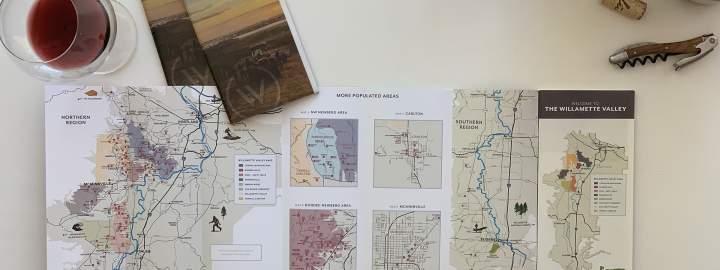Lasagne alla Besciamella
A FAVORITE FROM LINGUA FRANCA FOUNDER, LARRY STONE
This is not an American lasagna recipe, but a classic Lasagne alla Besciamella recipe. The ragu is not a “red” sauce and there is no mozzarella cheese all over it. Instead, it has a succulent and rich béchamel sauce. (You think béchamel is a French sauce?). The addition of a cured duck breast to the beef adds more flavor intensity and savoriness to the lasagna, but traditionally the beef would be mixed with ground pork). For harvest lasagna I often double the recipe and use a very large casserole pan to bake it in. I add a lot more freshly grated nutmeg than the recipe calls for and I add a couple of cloves of garlic. Season any recipe according to the freshness/intensity of your ingredients and your own palate.
The ragu is a classic Marcella Hazan recipe variation of mine.

Learn more about LINGUA FRANCA.
PAIRED WITH: Lingua Franca Estate Chardonnay
Ragu Bolognese
1 tablespoon vegetable oil
3 tablespoons butter
½ cup chopped onion
⅔ cup chopped celery
⅔ cup chopped carrot
¾ pound ground beef chuck (often I add nearly a pound)
4oz (quarter pound) of finely minced cured duck breast (duck prosciutto, duck bresaola, or air-dried duck breast) Some use chicken livers in this recipe instead of the duck. I’ve never tried it that way.
Salt to taste (about 1/4 teaspoon or more)
Black pepper, ground fresh from the mill
1 cup whole milk (some use light cream)
Whole nutmeg
1 cup dry white wine
1 cup canned imported Italian plum tomatoes, cut up, with their juice
optional: two cloves garlic while the beef finishes cooking, before the addition of milk.
PREPARATION
Step 1 Put the oil, butter and chopped onion in the pot and turn the heat on to medium. Cook and stir the onion until it has become translucent, then add the chopped celery and carrot. Cook for about 2 minutes, stirring vegetables to coat them well.
Step 2 Add ground beef, a large pinch of salt and a few grindings of pepper. Crumble the ground meat with a fork, stir in the pot with minced duck well and cook until the beef has lost its raw, red color.
Step 3 Add milk and let it simmer gently, stirring frequently, until it has bubbled away completely. Add about 1/8 teaspoon to ¼ teaspoon of nutmeg and stir.
Step 4 Add the wine, let it simmer until it has evaporated, then add the tomatoes and stir thoroughly to coat all ingredients well. The tomatoes recommended are whole peeled imported San Marzano tomatoes, which by law cannot be exported in any other form from Italy. These should be chopped into small pieces and the pieces and juice used. When the tomatoes begin to bubble, turn the heat down so that the sauce cooks at a low simmer, with just an intermittent bubble breaking through to the surface. Cook, uncovered, for 3 hours or more, stirring from time to time. While the sauce is cooking, you are likely to find that it begins to dry out and the fat separates from the meat. To keep it from sticking, add 1/2 cup of water whenever necessary. At the end, however, no water at all must be left and the fat must separate from the sauce. Taste and correct for salt.
Lasagne Noodle preparation
6-8 quarts of water
1 tablespoon salt
¾ pound lasagne noodles
Preheat the oven to 350°.
PREPARATION Generously butter the bottom and sides of a 9-by-12-by-3-inch serving casserole or baking dish. In a large soup pot or kettle, bring the water and salt to a bubbling boil over high heat. Add the lasagne, stirring gently for a few moments with a wooden fork to be sure the strips do not stick to one another. Boil over high heat, stirring occasionally, until the lasagne is tender, but still al dente-the time may vary between 10 and 25 minutes, depending on whether you use homemade or commercial lasagne. Set the pot under cold running water for a few moments to cool the pasta. Then lift out the strips and spread them side by side on dry towels to drain. If you are behind in getting the pasta together with the sauce, butter the strips lightly or use a thin layer of olive oil and place them on sheet pans to prevent them sticking to the towels or the pan. To make sure, I also butter the pan. If you overcook the pasta it will fall apart when you handle it. Remember after you assemble the dish, it still has a long time baking so the pasta will soak up ragu juices if it is really al dente, otherwise not.
Besciamella for Lasagne
3 tablespoons butter
6 tablespoons flour
2 cups whole milk
1 cup heavy cream
Ground nutmeg to taste (anything from ¼ teaspoon up)
1 teaspoon salt
PREPARATION In a heavy 2-to-3-quart saucepan, melt the butter over moderate heat and stir in the flour. Remove the pan from the heat and pour in the milk and cream all at once, beating with a wire whisk until the flour is partially dissolved. Return the pan to high heat and cook, stirring constantly with the whisk. When the sauce comes to a boil and thickens into a smooth cream, reduce the heat and simmer, still stirring, for 2 or 3 minutes. Remove from the heat and season with nutmeg and salt.
Final Assembly
Besciamella Ragu
bolognese you made earlier
1/2 cup freshly grated imported Parmesan cheese
Lasagne noodles
ASSEMBLY Spread a layer of ragu Bolognese about 1/4 inch deep evenly over the bottom of a standard lasagne pan 9x3x13. I use a Le Creuset cast iron casserole that measures 9 ½” wide, 3“ tall and 15” long but I know to make about a batch and a half for that pan. However, if you double the recipe you can use the Le Creuset Roasting pan which is 16.7”x 10.7” and 3.3” deep. Spread over it about 1 cup of besciamella. Lay one third of the Lasagne on the besciamella, overlapping the strips slightly. Repeat the layers of ragu, besciamella and Lasagne two more times, then top with the rest of the ragu and a masking of besciamella. Sprinkle with grated cheese. Bake 30 minutes, or until the sauce is bubbling hot.






